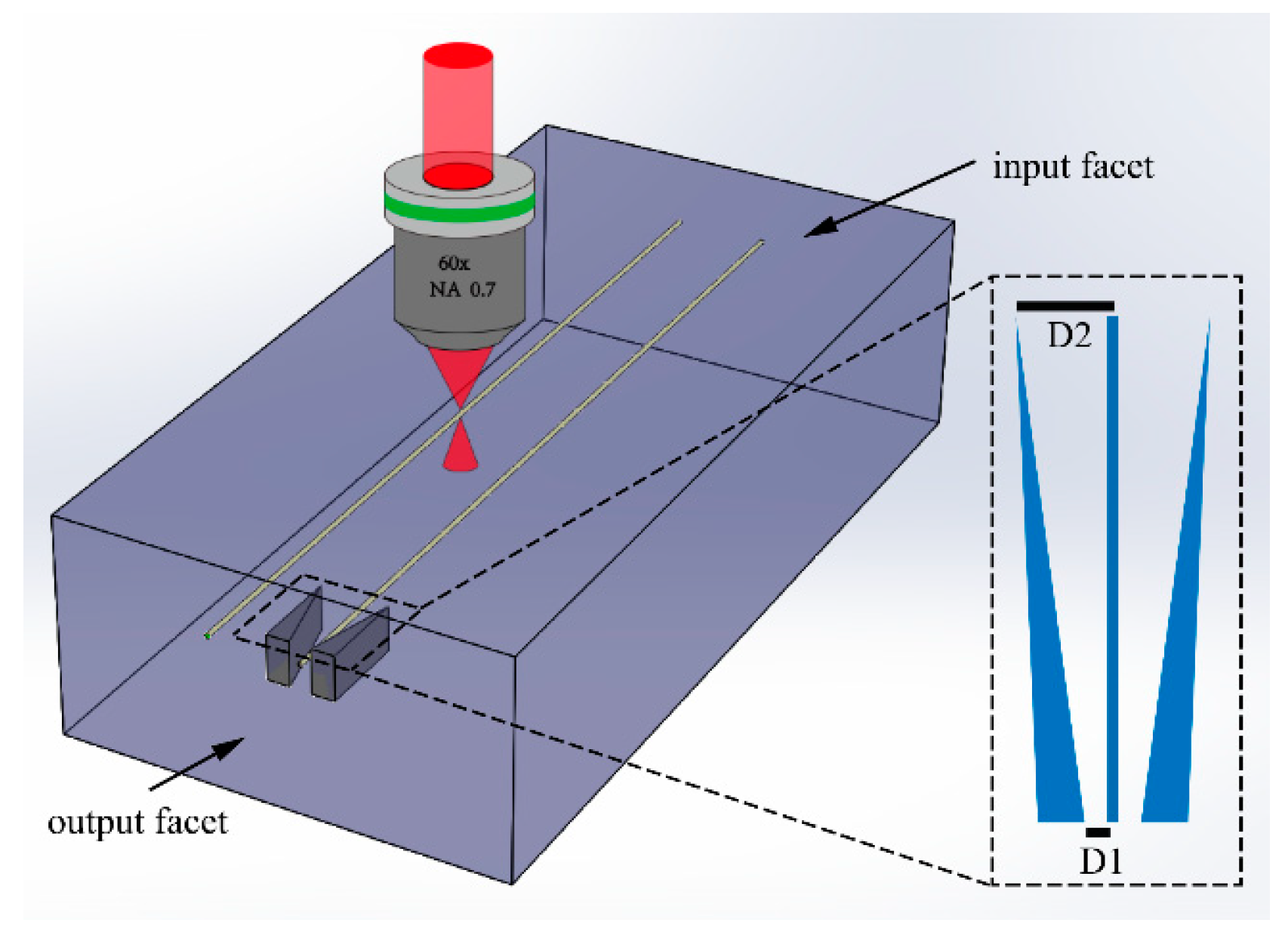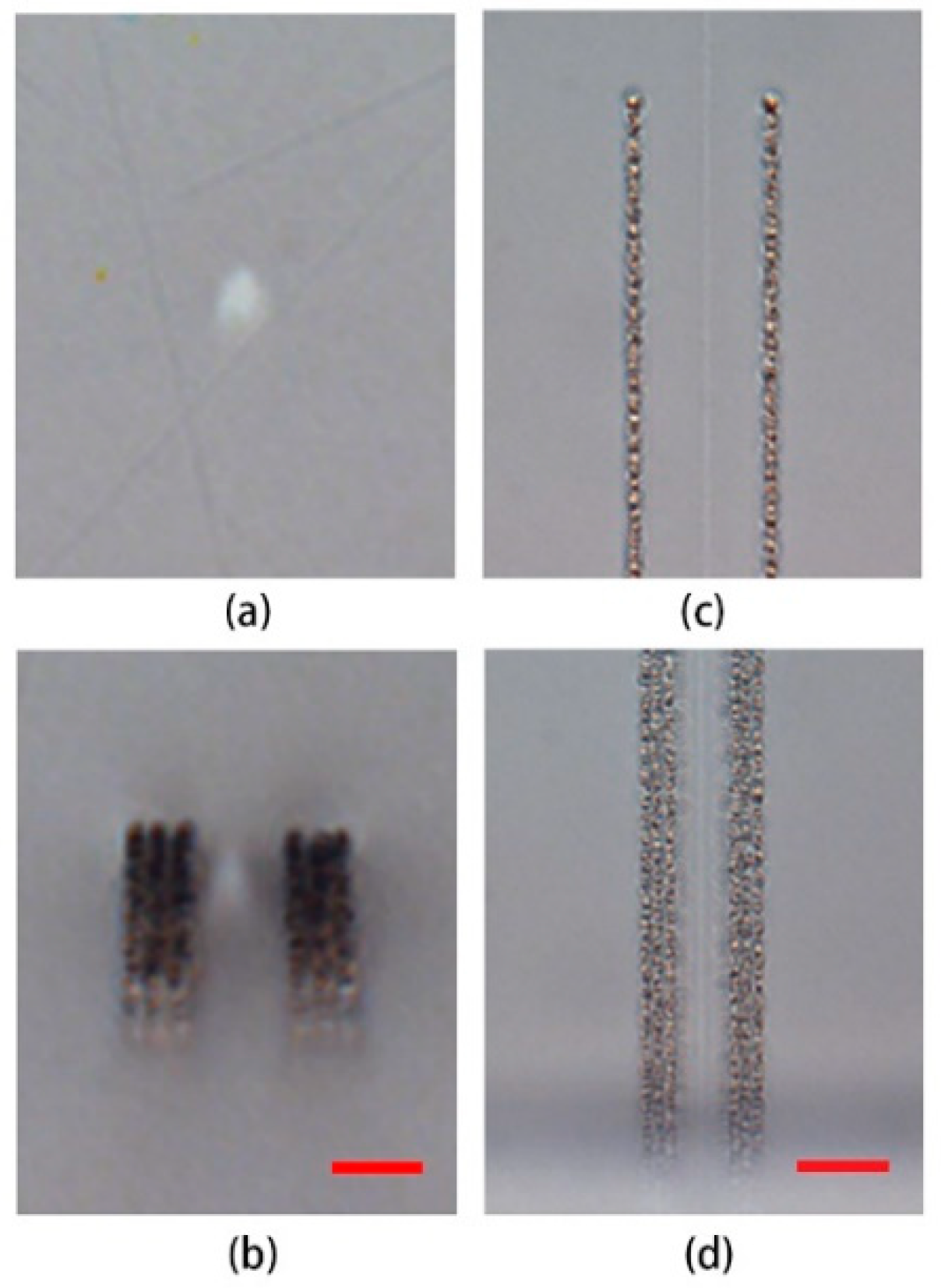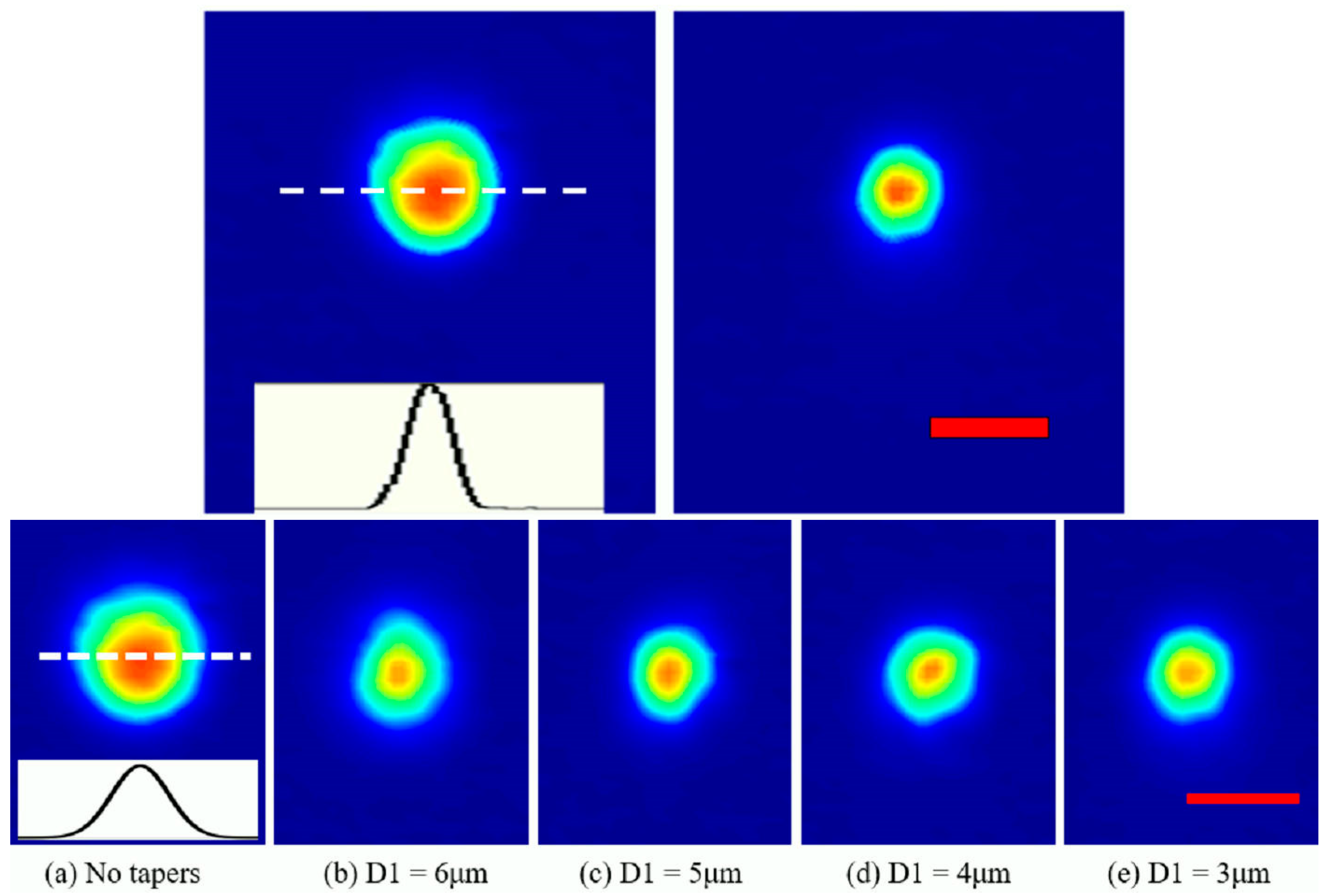Fabrication of an Optical Waveguide-Mode-Field Compressor in Glass Using a Femtosecond Laser
Abstract
1. Introduction
2. Materials and Methods
3. Results and Discussions
4. Conclusions
Author Contributions
Funding
Conflicts of Interest
References
- Davis, K.M.; Miura, K.; Sugimoto, N.; Hirao, K. Writing waveguides in glass with a femtosecond laser. Opt. Lett. 1996, 21, 1729–1731. [Google Scholar] [CrossRef] [PubMed]
- Efimov, O.M.; Glebov, L.B.; Richardson, K.A.; Van Stryland, E.; Cardinal, T.; Park, S.H.; Couzi, M.; Bruneel, J.L. Waveguide writing in chalcogenide glasses by a train of femtosecond laser pulses. Opt. Mater. 2001, 17, 379–386. [Google Scholar] [CrossRef]
- Nolte, S.; Will, M.; Burghoff, J.; Tuennermann, A. Femtosecond waveguide writing: A new avenue to three-dimensional integrated optics. Appl. Phys. A Mater. Sci. Process. 2003, 77, 109–111. [Google Scholar] [CrossRef]
- Rodenas, A.; Torchia, G.A.; Lifante, G.; Cantelar, E.; Lamela, J.; Jaque, F.; Roso, L.; Jaque, D. Refractive index change mechanisms in femtosecond laser written ceramic Nd:YAG waveguides: Micro-spectroscopy experiments and beam propagation calculations. Appl. Phys. B Lasers Opt. 2009, 95, 85–96. [Google Scholar] [CrossRef]
- Chen, F.; de Aldana, J.R.V. Optical waveguides in crystalline dielectric materials produced by femtosecond- laser micromachining. Laser Photon. Rev. 2014, 8, 251–275. [Google Scholar] [CrossRef]
- Zoubir, A.; Richardson, M.; Rivero, C.; Schulte, A.; Lopez, C.; Richardson, K.; Ho, N.; Vallee, R. Direct femtosecond laser writing of waveguides in As2S3 thin films. Opt. Lett. 2004, 29, 748–750. [Google Scholar] [CrossRef] [PubMed]
- Watanabe, W.; Sowa, S.; Tamaki, T.; Itoh, K.; Nishii, J. Three-dimensional waveguides fabricated in poly (methyl methacrylate) by a femtosecond laser. Jpn. J. Appl. Phys. Part 2 Lett. Express Lett. 2006, 45, L765–L767. [Google Scholar] [CrossRef]
- Choudhury, D.; Macdonald, J.R.; Kar, A.K. Ultrafast laser inscription: Perspectives on future integrated applications. Laser Photon. Rev. 2014, 8, 827–846. [Google Scholar] [CrossRef]
- Sugioka, K.; Cheng, Y. Ultrafast lasers-reliable tools for advanced materials processing. Light-Sci. Appl. 2014, 3, e149. [Google Scholar] [CrossRef]
- Salamu, G.; Jipa, F.; Zamfirescu, M.; Pavel, N. Cladding waveguides realized in Nd:YAG ceramic by direct femtosecond-laser writing with a helical movement technique. Opt. Mater. Express 2014, 4, 790–797. [Google Scholar] [CrossRef]
- Thomas, J.; Heinrich, M.; Burghoff, J.; Nolte, S.; Ancona, A.; Tunnermann, A. Femtosecond laser-written quasi-phase-matched waveguides in lithium niobate. Appl. Phys. Lett. 2007, 91, 151108. [Google Scholar] [CrossRef]
- Eaton, S.M.; Ng, M.L.; Osellame, R.; Herman, P.R. High refractive index contrast in fused silica waveguides by tightly focused, high-repetition rate femtosecond laser. J. Non-Cryst. Solids 2011, 357, 2387–2391. [Google Scholar] [CrossRef]
- Vitek, D.N.; Block, E.; Bellouard, Y.; Adams, D.E.; Backus, S.; Kleinfeld, D.; Durfee, C.G.; Squier, J.A. Spatio-temporally focused femtosecond laser pulses for nonreciprocal writing in optically transparent materials. Opt. Express 2010, 18, 24673–24678. [Google Scholar] [CrossRef] [PubMed]
- Jing, C.R.; Wang, Z.H.; Cheng, Y. Characteristics and Applications of Spatiotemporally Focused Femtosecond Laser Pulses. Appl. Sci. Basel 2016, 6, 428. [Google Scholar] [CrossRef]
- Diez-Blanco, V.; Siegel, J.; Ferrer, A.; de la Cruz, A.R.; Solis, J. Deep subsurface waveguides with circular cross section produced by femtosecond laser writing. Appl. Phys. Lett. 2007, 91, 051104. [Google Scholar] [CrossRef]
- Ams, M.; Marshall, G.D.; Spence, D.J.; Withford, M.J. Slit beam shaping method for femtosecond laser direct-write fabrication of symmetric waveguides in bulk glasses. Opt. Express 2005, 13, 5676–5681. [Google Scholar] [CrossRef] [PubMed]
- Salter, P.S.; Jesacher, A.; Spring, J.B.; Metcalf, B.J.; Thomas-Peter, N.; Simmonds, R.D.; Langford, N.K.; Walmsley, I.A.; Booth, M.J. Adaptive slit beam shaping for direct laser written waveguides. Opt. Lett. 2012, 37, 470–472. [Google Scholar] [CrossRef] [PubMed]
- Qi, J.; Wang, P.; Liao, Y.; Chu, W.; Liu, Z.M.; Wang, Z.H.; Qiao, L.L.; Cheng, Y. Fabrication of polarization-independent single-mode waveguides in lithium niobate crystal with femtosecond laser pulses. Opt. Mater. Express 2016, 6, 2554–2559. [Google Scholar] [CrossRef]
- Liao, Y.; Qi, J.; Wang, P.; Chu, W.; Wang, Z.H.; Qiao, L.L.; Cheng, Y. Transverse writing of three-dimensional tubular optical waveguides in glass with a slit-shaped femtosecond laser beam. Sci. Rep. 2016, 6, 28790. [Google Scholar] [CrossRef] [PubMed]
- Douglass, G.; Dreisow, F.; Gross, S.; Withford, M.J. Femtosecond laser written arrayed waveguide gratings with integrated photonic lanterns. Opt. Express 2018, 26, 1497–1505. [Google Scholar] [CrossRef] [PubMed]
- Gross, S.; Riesen, N.; Love, J.D.; Withford, M.J. Three-dimensional ultra-broadband integrated tapered mode multiplexers. Laser Photon. Rev. 2014, 8, L81–L85. [Google Scholar] [CrossRef]
- Zilberberg, O.; Huang, S.; Guglielmon, J.; Wang, M.; Chen, K.P.; Kraus, Y.E.; Rechtsman, M.C. Photonic topological boundary pumping as a probe of 4D quantum Hall physics. Nature 2018, 553, 59–62. [Google Scholar] [CrossRef] [PubMed]
- Atzeni, S.; Rab, A.S.; Corrielli, G.; Polino, E.; Valeri, M.; Mataloni, P.; Spagnolo, N.; Crespi, A.; Sciarrino, F.; Osellame, R. Integrated sources of entangled photons at the telecom wavelength in femtosecond-laser-written circuits. Optica 2018, 5, 311–314. [Google Scholar] [CrossRef]
- Heilmann, R.; Greganti, C.; Grafe, M.; Nolte, S.; Walther, P.; Szameit, A. Tapering of femtosecond laser-written waveguides. Appl. Opt. 2018, 57, 377–381. [Google Scholar] [CrossRef] [PubMed]
- Liu, Z.M.; Liao, Y.; Fang, Z.W.; Chu, W.; Cheng, Y. Suppression of bend loss in writing of three-dimensional optical waveguides with femtosecond laser pulses. Sci. China Phys. Mech. Astron. 2018, 61, 070322. [Google Scholar] [CrossRef]
- Lancry, M.; Poumellec, B.; Canning, J.; Cook, K.; Poulin, J.C.; Brisset, F. Ultrafast nanoporous silica formation driven by femtosecond laser irradiation. Laser Photon. Rev. 2013, 7, 953–962. [Google Scholar] [CrossRef]
- Marcinkevicius, A.; Juodkazis, S.; Matsuo, S.; Mizeikis, V.; Misawa, H. Application of Bessel beams for microfabrication of dielectrics by femtosecond laser. Jpn. J. Appl. Phys. Part 2 Lett. 2001, 40, L1197–L1199. [Google Scholar] [CrossRef]
- Chan, J.W.; Huser, T.; Risbud, S.; Krol, D.M. Structural changes in fused silica after exposure to focused femtosecond laser pulses. Opt. Lett. 2001, 26, 1726–1728. [Google Scholar] [CrossRef] [PubMed]
- Dai, Y.; Patel, A.; Song, J.; Beresna, M.; Kazansky, P.G. Void-nanograting transition by ultrashort laser pulse irradiation in silica glass. Opt. Express 2016, 24, 19344–19353. [Google Scholar] [CrossRef] [PubMed]
- Bressel, L.; de Ligny, D.; Gamaly, E.G.; Rode, A.V.; Juodkazis, S. Observation of O-2 inside voids formed in GeO2 glass by tightly-focused fs-laser pulses. Opt. Mater. Express 2011, 1, 1150–1157. [Google Scholar] [CrossRef]
- Champion, A.; Beresna, M.; Kazansky, P.; Bellouard, Y. Stress distribution around femtosecond laser affected zones: Effect of nanogratings orientation. Opt. Express 2013, 21, 24942–24951. [Google Scholar] [CrossRef] [PubMed]
- Canning, J.; Lancry, M.; Cook, K.; Weickman, A.; Brisset, F.; Poumellec, B. Anatomy of a femtosecond laser processed silica waveguide. Opt. Mater. Express 2011, 1, 998–1008. [Google Scholar] [CrossRef]



| D1 | MFD (μm) | ΔIL (dB) |
|---|---|---|
| NA (no taper) | 10.0 | -- |
| 6 | 7.8 | NA |
| 5 | 7.3 | NA |
| 4 | 7.4 | 0.15 |
| 3 | 7.2 | 0.32 |
© 2018 by the authors. Licensee MDPI, Basel, Switzerland. This article is an open access article distributed under the terms and conditions of the Creative Commons Attribution (CC BY) license (http://creativecommons.org/licenses/by/4.0/).
Share and Cite
Liu, Z.; Liao, Y.; Wang, Z.; Zhang, Z.; Liu, Z.; Qiao, L.; Cheng, Y. Fabrication of an Optical Waveguide-Mode-Field Compressor in Glass Using a Femtosecond Laser. Materials 2018, 11, 1926. https://doi.org/10.3390/ma11101926
Liu Z, Liao Y, Wang Z, Zhang Z, Liu Z, Qiao L, Cheng Y. Fabrication of an Optical Waveguide-Mode-Field Compressor in Glass Using a Femtosecond Laser. Materials. 2018; 11(10):1926. https://doi.org/10.3390/ma11101926
Chicago/Turabian StyleLiu, Zhengming, Yang Liao, Zhenhua Wang, Zhihao Zhang, Zhaoxiang Liu, Lingling Qiao, and Ya Cheng. 2018. "Fabrication of an Optical Waveguide-Mode-Field Compressor in Glass Using a Femtosecond Laser" Materials 11, no. 10: 1926. https://doi.org/10.3390/ma11101926
APA StyleLiu, Z., Liao, Y., Wang, Z., Zhang, Z., Liu, Z., Qiao, L., & Cheng, Y. (2018). Fabrication of an Optical Waveguide-Mode-Field Compressor in Glass Using a Femtosecond Laser. Materials, 11(10), 1926. https://doi.org/10.3390/ma11101926






